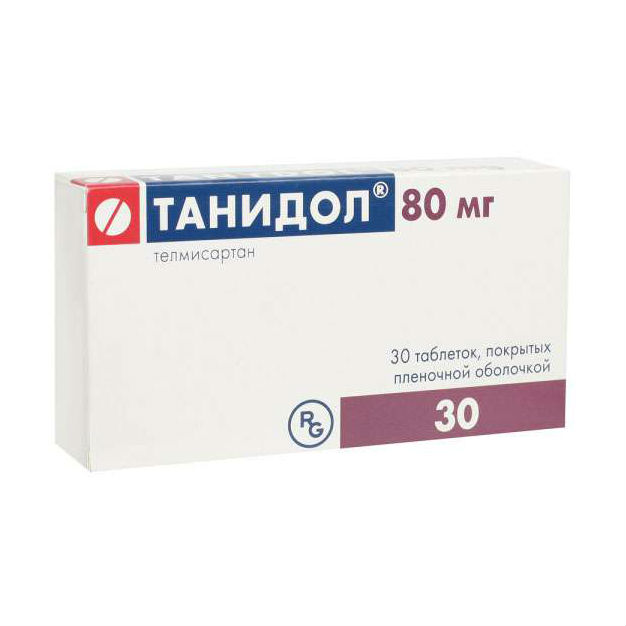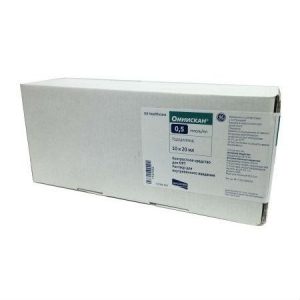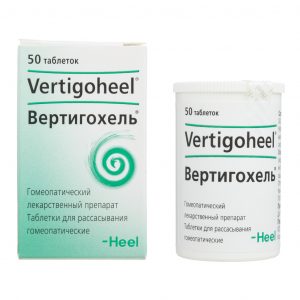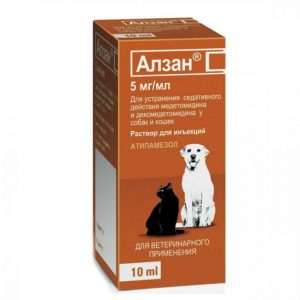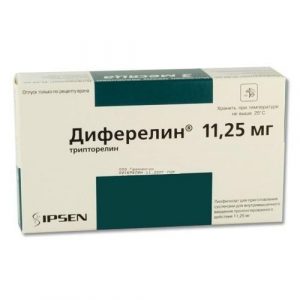Description
Pharmacological action of
Telmisartan is a specific angiotensin II receptor antagonist (type AT1), has a high affinity for the AT1 subtype of angiotensin II, through which angiotensin II acts.
Telmisartan does not show any activity as an AT1 receptor agonist. Telmisartan selectively binds to the AT1 receptor. Binding is continuous. Telmisartan does not show affinity for other receptors, including the AT2 receptor and other less studied angiotensin receptors. The functional role of these receptors is unknown, the effect of their possible increased stimulation with angiotensin II, the level of which increases under the action of telmisartan, is also unknown.
Telmisartan reduces the concentration of aldosterone in blood plasma, does not reduce renin activity in blood plasma and does not block ion channels. Telmisartan does not inhibit the angiotensin converting enzyme (kininase II), which also catalyzes the degradation of bradykinin. This avoids the side effects associated with the action of bradykinin.
Telmisartan at a dose of 80 mg completely blocks the hypertensive effect of angiotensin II in patients. The effective effect of the drug lasts more than 24 hours and is still noticeable after 48 hours.
After the first dose of telmisartan, the onset of antihypertensive action is noted within three hours. The maximum decrease in blood pressure is usually achieved 4 to 8 weeks after the start of treatment and persists with long-term treatment. Antihypertensive effect persists for more than 24 hours after taking the drug.
In patients with arterial hypertension, telmisartan reduces both systolic and diastolic blood pressure without affecting the heart rate.
In the case of abrupt cancellation of telmisartan, blood pressure gradually (over several days) returns to its original values ² ¹ ² ¹without the development of “withdrawal” syndrome.
In comparative clinical studies, the incidence of dry cough was significantly lower in patients treated with telmisartan compared with those who received angiotensin converting enzyme inhibitors.
The effectiveness of reducing the risk of cardiovascular mortality with doses of telmisartan less than 80 mg has not been studied.
Pharmacokinetics
Absorption
After oral administration, telmisartan is rapidly absorbed from the gastrointestinal tract. Bioavailability is about 50%. When taking telmisartan simultaneously with food, the decrease in area under the concentration-time curve (AUC) for telmisartan varies from 6% (at a dose of 40 mg) to 19% (at a dose of 160 mg). 3 hours after taking the drug, the concentration of telmisartan in the blood plasma is equalized regardless of the drug taken on an empty stomach or with food.
Linearity / Nonlinearity
It is not expected that a slight decrease in AUC may cause a decrease in therapeutic efficacy. There is no linear relationship between the dose and the concentration of the drug in blood plasma. At doses greater than 40 mg, the maximum plasma concentration (Cmax) and, to a lesser extent, AUC increase disproportionately.
Distribution of
Telmisartan is actively associated with plasma proteins (more than 99.5%), mainly with albumin and alpha-1 acid glycoprotein. The average value of the apparent volume of distribution at the equilibrium stage (Vdss) is approximately 500 L.
Metabolism
Telmisartan is metabolized through conjugation of the starting material with glucuronide. No pharmacological activity of the conjugate was detected.
Excretion
Telmisartan is characterized by the pharmacokinetics of biexponential decay with a final half-life of more than 20 hours. The maximum plasma concentration (Cmax) and, to a lesser extent, the area under the concentration-time curve (AUC) increases disproportionately with the dose. There is no evidence that accumulation of telmisartan when taken in recommended doses is of clinical significance. Plasma concentrations were higher in women compared with men, but there was no corresponding effect on efficacy.
After administration of the drug inside (and intravenously), telmisartan is excreted almost exclusively through the intestines, mainly unchanged. The total amount excreted by the kidneys is less than 1% of the dose. The total plasma clearance (Cltot) is high (about 1000 ml / min) compared with hepatic blood flow (about 1500 ml / min).
Pharmacokinetics in special patient groups
Gender differences
There were differences in plasma concentrations of Cmax and AUC in women compared with men, they were about 3 and 2 times higher, respectively.
Elderly patients
The pharmacokinetics of telmisartan in elderly patients and patients under the age of 65 are not different.
Patients with renal failure
Dose adjustment in patients with renal failure is not required, including patients being on hemodialysis. Telmisartan is actively associated with plasma proteins in patients with renal failure and is not excreted during dialysis. The elimination half-life in patients with renal failure does not change.
Patients with hepatic impairment
Pharmacokinetic studies in patients with hepatic impairment revealed an increase in absolute bioavailability of up to almost 100%. The half-life in patients with hepatic insufficiency does not change.
Indications
– Hypertension
– Reduced cardiovascular morbidity and mortality in patients aged 55 years and older with a high risk of cardiovascular disease.
Contraindications
Hypersensitivity to the active substance or other components of the drug
Pregnancy and lactation
Obstructive diseases of the biliary tract
Children (under 18 years)
Lactase deficiency, lactose intolerance, glucose-galactose malabsorption
Severe hepatic impairment (Child-Pugh class C (10-15 points))
Primary aldosteronism.
With caution
Bilateral renal artery stenosis, single kidney artery stenosis, impaired renal and / or liver function, condition after kidney transplantation (no experience with the use), decreased blood volume due to previous diuretic therapy, restriction of sodium chloride, diarrhea or vomiting, hyponatremia, hyperkalemia, chronic heart failure, aortic and / or mitral valve stenosis, hypertrophic obstructive cardiomyopathy, ischemic heart disease.
Special instructions
Before and during treatment with Tanidol ®, monitoring of blood pressure, kidney function, and serum potassium is necessary. Transient arterial hypotension is not a contraindication for further treatment with Tanidol ® after stabilization of blood pressure. In case of repeated occurrence of severe arterial hypotension, the dose should be reduced or the drug should be discontinued. In the presence of renal failure, treatment is carried out with caution under the control of serum creatinine concentration.
Hepatic insufficiency
Tanidol ® should not be used in patients with cholestasis, biliary obstruction, or acute liver failure, since telmisartan is mainly excreted in the bile. It is assumed that such patients have reduced hepatic clearance of telmisartan. Tanidol ® should be used with extreme caution in patients with mild or moderate hepatic impairment.
Renovascular hypertension
When treated with drugs that act on the renin-angiotensin-aldosterone system (RAAS), patients with bilateral renal artery stenosis and single-artery stenosis increase the risk of severe arterial hypotension and renal failure.
Renal failure and kidney transplantation
When using Tanidol ® in patients with impaired renal function, periodic monitoring of serum potassium and creatinine is recommended. There is no clinical experience with the use of Tanidol ® in patients who have recently undergone kidney transplantation.
Decreased circulating blood volume (BCC)
In patients with a decrease in BCC and / or sodium due to previous diuretic therapy, restriction of salt, diarrhea or vomiting, symptomatic hypotension may occur, especially after the first dose of Tanidol ®. Similar conditions should be eliminated before its reception. A deficiency of fluid and / or sodium should be eliminated before taking Tanidol ®.
Double blockade of the renin-angiotensin-aldosterone system
As the effects of inhibition of RAAS were noted: the occurrence of arterial hypotension, syncope, hyperkalemia and impaired renal function (including acute renal failure) in patients predisposed to this, especially when used in combination with drugs also acting on this system. Double blockade of RAAS, for example, when an ACE inhibitor (angiotensin-converting enzyme) is added to an angiotensin II receptor antagonist, is not recommended for patients with already controlled blood pressure and should be limited to individual cases with enhanced monitoring of renal function.
Other diseases characterized by stimulation of RAAS
In patients whose vascular tone and renal function mainly depend on RAAS activity (for example, patients with chronic heart failure or kidney disease, including renal artery stenosis), the use of drugs, acting on this system, such as telmisartan, has been associated with the occurrence of acute arterial hypotension, hyperazotemia, oliguria, or rarely with acute renal failure.
Primary aldosteronism
Patients with primary aldosteronism, as a rule, do not respond to treatment with antihypertensive drugs, the effect of which is manifested by inhibition of RAAS. In this regard, the use of the drug Tanidol ® in these cases is not recommended.
Aortic and mitral valve stenosis, hypertrophic obstructive cardiomyopathy
As with other vasodilators, special precautions are indicated for patients with aortic imitated stenosis or hypertrophic obstructive cardiomyopathy.
Hyperkalemia
Use of drugs acting on the RAAS, may cause hyperkalemia.
For elderly patients, patients with renal failure, patients with diabetes mellitus and also with arterial hypertension and coronary heart disease (CHD), patients receiving concomitant drug therapy that may cause an increase in potassium, and / or patients with concomitant disease hyperkalemia can be fatal.
Before considering the possible concomitant use of drugs acting on the RAAS, it is necessary to assess the benefit-risk ratio.
The main risk factors that should be considered are:
– Diabetes mellitus, renal failure, age (patients older than 70 years).
– Combination with one or more drugs, acting on RAAS and / or an increase in serum potassium. Medicinal products or therapeutic classes of drugs that can cause hyperkalemia are salt substitutes containing potassium, potassium-sparing diuretics, ACE inhibitors, angiotensin II receptor antagonists, non-steroid drugs (NSAIDs, including selective COX-2 inhibitors), heparin, immunosuppressants cyclosporine or tacrolimus) and trimethoprim.
– Intercurrent diseases, especially dehydration, acute heart failure, metabolic acidosis, impaired renal function, a sharp deterioration in the condition of the kidneys (e.g., infectious diseases), cytolysis syndrome (e.g., acute limb ischemia, rhabdomyolysis, severe trauma). For patients at risk, regular monitoring of serum potassium is recommended.
Lactose
This medication contains lactose monohydrate. Patients with rare inherited diseases, such as galactose intolerance, Lapp lactase deficiency, or malabsorption of glucose-galactose, should not take this medication.
Racial differences
As noted for angiotensin-converting enzyme (ACE) inhibitors, Tanidol ® and other angiotensin II receptor antagonists appear to lower blood pressure in patients of the Negroid race than in other races, possibly due to a greater predisposition to lower the renin activity of the population of patients of the Negroid race, patients with diabetes mellitus and also with arterial hypertension and coronary heart disease.
Other
As with other antihypertensive drugs, an excessive decrease in blood pressure in patients with ischemic cardiopathy or in patients with diabetes mellitus and also with hypertension and coronary heart disease can lead to myocardial infarction or impaired cerebral circulation.
Influence on the ability to drive vehicles and to work with equipment
There have been no special studies of the effect of the drug on the ability to drive vehicles and to work with equipment. Care must be taken when driving vehicles, as well as when working with equipment (risk of dizziness and drowsiness).
Composition
Active ingredient:
telmisartan 80 mg.
Excipients:
sodium hydroxide 6.70 mg,
povidone-K25 24.00 mg,
meglumine 24.00 mg,
lactose monohydrate 434.70 mg,
crospovidone 24.00 mg,
iron dye yellow oxide 0, 60 mg,
magnesium stearate 6.00 mg.
Film coating (opadry yellow) 18.00 mg: hypromellose-5cP 10.817 mg, titanium dioxide 5.409 mg, macrogol-400 1.082 mg, talc 0.346 mg, iron dye yellow oxide 0.346 mg.
Dosage and administration
Inside, regardless of food intake.
Hypertension
The initial dose is usually 40 mg once daily. In case of failure to achieve blood pressure targets, the dose of the drug can be increased to a maximum (80 mg) once a day. Alternatively, Tanidol ® can be used in combination with thiazide diuretics, such as hydrochlorothiazide, which, when used simultaneously, has shown an additive antihypertensive effect.
If it is necessary to increase the dose, it should be borne in mind that the maximum antihypertensive effect usually develops 4-8 weeks after the start of treatment.
Decreased cardiovascular morbidity and mortality
The recommended dose is 80 mg once daily. Regular monitoring of blood pressure and, if necessary, dose adjustment of drugs that lower blood pressure is recommended.
Special patient populations
Renal failure: in patients with mild or moderate renal failure, dose adjustment is not required. The experience of use in patients with severe renal insufficiency or in patients requiring hemodialysis is limited.
Hepatic impairment: in patients with mild or moderate hepatic impairment, the daily dose should not exceed 40 mg.
Elderly patients
Dose adjustment is not required for elderly patients.
Children
Tanidol ® is not recommended for children under 18 years of age due to the lack of sufficient data on safety and effectiveness.
Side effects
In general, the incidence of adverse events observed for telmisartan (41.4%) is comparable to that for placebo (43.9%). The incidence of adverse events was not dose-dependent and did not correlate with the gender, age, or race of the patients.
Adverse adverse reactions are presented in accordance with the frequency of occurrence: very often ( 1/10) often ( 1/100 to <1/10) infrequently ( 1/1000 to <1/100) rarely ( 1/10000 to <1/1000) very rarely ( <1/10000), of unknown frequency (based on the available data, it is impossible to estimate). In each frequency group, adverse reactions are presented in decreasing order of severity. Infections and infestations Infrequently: upper respiratory tract infection, including pharyngitis and sinusitis, urinary tract infection, including cystitis Unknown frequency: sepsis, including death. Disorders of the blood and lymphatic system Infrequently: anemia Rarely: thrombocytopenia Unknown frequency: eosinophilia. Immune system disorders Rarely: hypersensitivity Unknown frequency: anaphylactic reactions. Disorders of nutrition and metabolism Infrequently: hyperkalemia. Mental disorders Infrequently: depression, insomnia Rarely: anxiety. Disorders of the nervous system Infrequently: syncope. Visual disturbances Rarely: visual impairment. Impaired hearing and balance Infrequently: vertigo. Disorders of the cardiovascular system Infrequently: bradycardia, marked decrease in blood pressure *, orthostatic hypotension Rarely: tachycardia. * Often observed in patients with controlled blood pressure who received telmisartan treatment to reduce the risk of cardiovascular mortality in addition to standard treatment. Disorders of the respiratory system, chest and mediastinal organs Uncommon: shortness of breath. Digestive disorders Infrequently: abdominal pain, diarrhea, dyspepsia, flatulence, vomiting Rarely: upset stomach, discomfort, dry mucous membrane of the oral cavity. Hepatobiliary disorders Rarely: impaired liver function / liver disease. Disorders of the skin and subcutaneous tissue Infrequently: hyperhidrosis, skin itching, rash Rarely: erythema, angioedema (including death), drug rash, toxic skin rash, eczema Unknown frequency: urticaria. Disorders of the musculoskeletal system and connective tissue Infrequently: myalgia, back pain (e.g. sciatica), muscle cramps Rarely: arthralgia, pain in the extremities Unknown frequency: pain in the tendon area (tendonitis-like symptoms). Urinary system disorders Infrequently: renal failure, including acute renal failure. Systemic disorders Infrequently: chest pain, asthenia (weakness) Rarely: flu-like condition. Laboratory indicators Infrequently: increased blood creatinine concentration Rarely: increased uric acid concentration in the blood, ² Ñliver ² Ñ enzymes, serum creatine phosphokinase activity, decreased hemoglobin hypoglycemia (in patients with diabetes mellitus). Overdose Information on overdose is limited. Symptoms: the most significant – a pronounced decrease in blood pressure and tachycardia, bradycardia, dizziness, increased serum creatinine concentration and acute renal failure can also be observed. Treatment: The treatment should be symptomatic and supportive. Proposed measures include: inducing vomiting and / or gastric lavage, taking activated charcoal, and replenishing the lack of fluid and salts. The serum electrolytes and creatinine should be constantly monitored. Hemodialysis is not effective. Storage conditions At a temperature not exceeding 30 ° C. Keep out of the reach of children! Expiration 3 years. Do not use after the expiration date printed on the package. Deystvuyuschee substances Telmysartan Drugstore terms from drugstore recipe dosage form tablets
